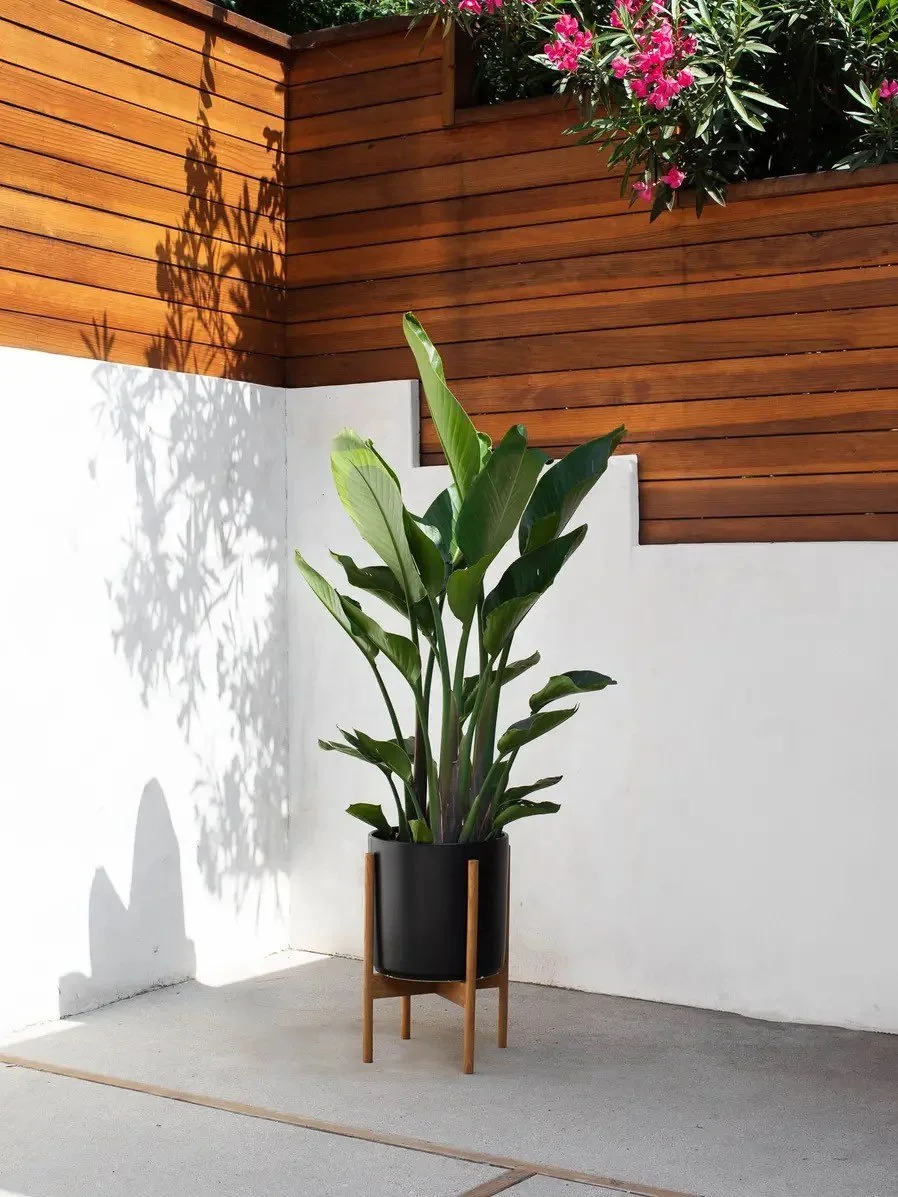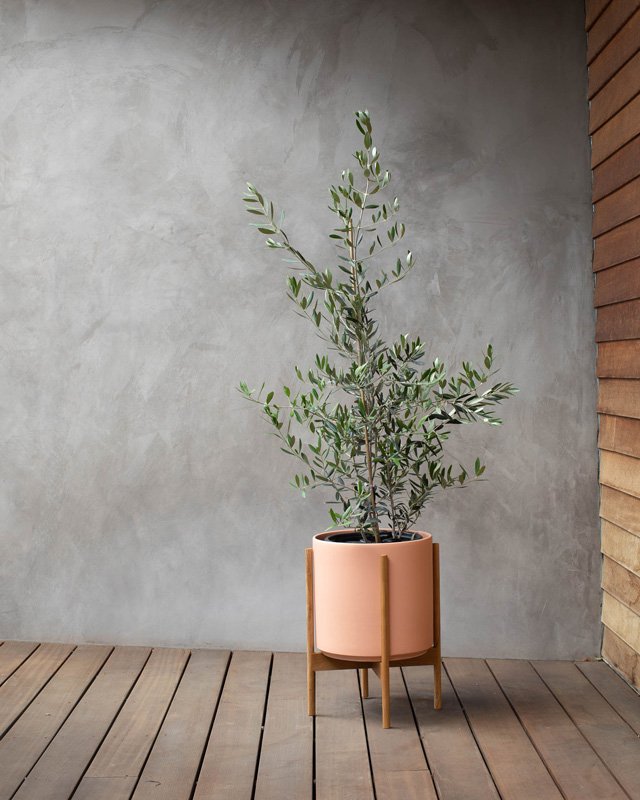The Absolute Best Poolside Plants
Olive Trees can add an elegant, Mediterranean touch to your poolside.
Summertime, and the living’s easy! When it comes to creating a serene and inviting poolside oasis, the right selection of plants can make all the difference. Poolside plants not only add a touch of natural beauty but also provide shade, privacy, and a refreshing ambiance. From poolside landscaping to perfect poolside potted plants, let’s explore which greenery is both visually appealing and well-suited to the unique environment near a swimming pool.
General Considerations for Poolside Plants
Before adding plants to your pool area, there are several important considerations to keep in mind. Planning your poolside landscaping will help ensure that the plants you choose are suitable for the pool environment and enhance the overall aesthetics and functionality of the space. Here are some key factors to consider:
Climate and USDA Growing Zones: Determine the climate and USDA growing zone of your region. Different plants thrive in different climates, so it's essential to choose plants that are well-adapted to your specific growing conditions. If you opt for potted plants, you can be a little more flexible here, as bringing them indoors for winter months is always an option.
Sun Exposure: Assess the amount of sunlight your pool area receives throughout the day. Some plants require full sun, while others prefer partial shade. Select plants that match the sun exposure in your pool area to ensure their healthy growth.
Water Requirements: Consider the proximity of your plants to the pool and the availability of water sources. Plants near the pool may receive splashes of water or increased humidity. Choose plants that can tolerate these conditions and have appropriate water requirements.
Pool Safety: Ensure that the plants you select do not have thorns, prickly leaves, or berries that could pose a safety hazard to swimmers. Avoid plants with shallow, invasive roots that can damage pool structures or clog filtration systems.
Maintenance: Consider the level of maintenance you are willing to undertake. Some plants require regular pruning, deadheading, or fertilizing, while others are low-maintenance. Select plants that align with your desired level of care.
Allergies and Irritants: Be aware of any potential allergies or sensitivities that you, your family, or guests may have to certain plants. Avoid plants with strong fragrances or pollen that can cause allergies or respiratory irritations.
Privacy and Screening: Determine if you desire additional privacy around your pool area. Select plants that can provide natural screening, such as tall shrubs or bamboo (see more suggestions below!), to create a more secluded and intimate space.
Aesthetics: Consider the overall design and style of your pool area. Choose plants that complement the architectural elements, color scheme, and theme of your outdoor space. Consider foliage textures, flower colors, and plant forms that harmonize with the pool surroundings.
Pool Maintenance: Take into account the impact of plants on pool maintenance. Avoid plants that drop excessive leaves, flowers, or debris into the pool, as this may increase the frequency of cleaning and maintenance tasks.
Safety with Chemicals: Be cautious when using chemicals, such as pool sanitizers and fertilizers, around plants. Some chemicals can harm or even kill certain plant species. Follow recommended guidelines to ensure the safety of both your plants and the pool!
Top Poolside Houseplants
The Bird of Paradise makes an excellent poolside plant.
If you’re not ready for a full-on landscaping project, adding just a few potted plants around your pool is an easy way to greatly enhance the area. This no-mess approach to pool plants is a great option for smaller spaces or individuals who don’t want too much maintenance over time. Plus, the versatility of potted plants allows you to move them around as needed, and even bring them indoors for the winter if needed.
Most houseplants can go adapt to outdoor conditions during the warmer months of the year. Indoor/outdoor patio plants are ideal for poolside plant decor, and here are some of our favorites!
BIRD OF PARADISE
Going for a tropical look? The Bird of Paradise makes a great poolside plants due to their large, glossy leaves and striking appearance. Though they don’t generally bloom indoors, they can in fact show off their vibrant flowers in outdoor settings! This plant can handle direct sunlight, but make sure to slowly acclimate it to very bright areas to avoid scorching the leaves.
OLIVE TREE
Olive Trees are unique pool plants as they offer both beauty and functionality. Their silvery-green foliage adds a Mediterranean charm, while their dense canopy provides shade and privacy. Additionally, they naturally repel pests!
FISHTAIL PALM
Fishtail Palms are great poolside plants as they provide dense foliage, offering privacy and shade. Suitable for both shady and sunny areas, the lush, feathery fronds taht resemble a fishtail add a tropical touch to your pool area, creating a relaxing and inviting atmosphere.
PONYTAIL PALM
A common plant in Mexican courtyards, Ponytail Palms are excellent poolplants because of their unique, eye-catching appearance with their long, arching leaves cascading down like a ponytail. They are drought-tolerant, low-maintenance, and their architectural form adds a touch of elegance to any poolside landscape.
desert cactus
Sun-loving and low-maintenance, the Desert Cactus is an instant statement to any poolside area. In reality a type of succulent, the Desert Cactus requires minimal care to keep it beautiful and thriving over time, and is perfect for pools with a desert aesthetic.
SNAKE PLANT
Snake Plants are ideal pool plants due to their ability to thrive in both full sun and shade conditions. Their tall, upright leaves bring a modern and architectural element to the pool area while requiring minimal care, making them perfect for busy pool owners.
false aralia
False Aralia plants are excellent pool plants due to their lush, tropical foliage and tolerance of different light conditions. Their wispy, serrated leaves create a dramatic and lush backdrop, adding a touch of luxury and visual interest to your pool area.
CALANDIVA
Looking for flowering plants for your pool? Calandiva plants are a type of succulent that are perfect for poolside containers or hanging baskets. With their abundant and colorful blooms, they add a splash of vibrant colors to your pool area, creating a cheerful and lively ambiance. They are also easy to care for, making them a popular choice for poolside plantings.
sago palm
Sago Palms are excellent poolside plants due to their ability to withstand heat, drought, and even salt spray near pools. Their glossy, dark green fronds add a touch of elegance and provide a tropical vibe, creating a lush and inviting atmosphere.
cast iron plant
For shady poolside areas, Cast Iron Plants are an excellent option due to their exceptional durability and ability to tolerate low light and neglect. Their dark green, leathery leaves provide a lush and tropical feel, making them an ideal choice for adding greenery to shady corners or under tall trees near the pool.
Poolside Landscaping Plants
Ready to start digging? If you’re planning on adding plants in the soil around your pool, consider these top pool landscaping plants that provide multiple benefits such as privacy and shade, and without a doubt enhance the aesthetic of your poolside oasis!
Palm Trees: Palm trees are iconic poolside plants, exuding a tropical vibe and adding a touch of luxury to any pool area. The Arecastrum romanzoffianum, commonly known as the Queen Palm, is an excellent choice. Its elegant feather-like fronds provide shade, and its slender trunk adds vertical interest.
USDA Growing Zones: 9-11
Sun Requirements: Full sun to partial shade
Soil Requirements: Well-draining soil
Bird of Paradise: The vibrant and exotic Bird of Paradise plant is an attention-grabbing addition to any poolside landscape. With its distinctive orange and blue flowers resembling the shape of a bird in flight, this plant adds a burst of color and drama.
USDA Growing Zones: 9-11
Sun Requirements: Full sun to partial shade
Soil Requirements: Well-draining soil
Agave: Agave plants are both hardy and visually striking, making them ideal for poolside environments. Their architectural rosettes of thick, fleshy leaves create a sculptural effect while requiring minimal maintenance. Varieties like Agave americana and Agave parryi are popular choices.
USDA Growing Zones: Varies by species (generally 8-11)
Sun Requirements: Full sun to partial shade
Soil Requirements: Well-draining soil
Hibiscus: The vibrant and large blooms of the Hibiscus make it a must-have plant for poolside areas. With a wide range of colors available, such as red, pink, orange, and yellow, these tropical beauties will add a burst of color to your poolside paradise.
USDA Growing Zones: 9-11
Sun Requirements: Full sun to partial shade
Soil Requirements: Well-draining soil
Lantana: Lantana is a versatile and hardy plant that thrives in warm climates. It offers clusters of tiny, colorful flowers in shades of pink, orange, yellow, and purple. Its long flowering season and ability to attract butterflies make it a delightful addition to any poolside garden.
USDA Growing Zones: 8-11
Sun Requirements: Full sun
Soil Requirements: Well-draining soil
Yucca: Yucca plants are known for their dramatic sword-like leaves and architectural form. They are drought-tolerant and low-maintenance, making them ideal for poolside landscaping. Yucca filamentosa and Yucca rostrata are popular species that can add a touch of desert charm.
USDA Growing Zones: Varies by species (generally 5-10)
Sun Requirements: Full sun
Soil Requirements: Well-draining soil
Purple Fountain Grass: For a touch of elegance and movement near your pool, consider planting Purple Fountain Grass. Its tall, burgundy-colored plumes sway gracefully in the breeze, creating a mesmerizing effect. This ornamental grass adds texture and drama to any poolside setting.
USDA Growing Zones: 9-11
Sun Requirements: Full sun
Soil Requirements: Well-draining soil
Society Garlic: Society Garlic is a versatile plant that offers more than just ornamental value. Its narrow green leaves and pretty lavender flowers produce a garlicky scent that deters pests. This perennial herb is an excellent choice for poolside gardens, and its edible flowers can even be used in cooking.
USDA Growing Zones: 7-11
Sun Requirements: Full sun to partial shade
Soil Requirements: Well-draining soil
Canna Lily: Canna Lilies are show-stoppers, known for their large, tropical-looking foliage and vibrant blooms. These plants love water and thrive in the moist conditions near a pool. With a range of flower colors available, including red, orange, yellow, and pink, they are sure to make a bold statement.
USDA Growing Zones: 7-11
Sun Requirements: Full sun to partial shade
Soil Requirements: Moist, well-draining soil
Bamboo: Bamboo is an excellent choice for poolside privacy and creating a serene atmosphere. With its fast growth and dense foliage, it can form a natural screen, blocking out unwanted views and providing a tranquil environment. Clumping bamboo species like Bambusa multiplex are recommended to prevent invasive spread.
USDA Growing Zones: Varies by species (generally 5-11)
Sun Requirements: Full sun to partial shade
Soil Requirements: Well-draining soil
Photo credit: @adriannetulod, @johnfo, @jonathanborba @clarkstudio












